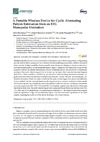Please use this identifier to cite or link to this item:
https://accedacris.ulpgc.es/handle/10553/71930
| DC Field | Value | Language |
|---|---|---|
| dc.contributor.author | Mendonca, Fabio | en_US |
| dc.contributor.author | Mostafa, Sheikh Shanawaz | en_US |
| dc.contributor.author | Morgado-Dias, Fernando | en_US |
| dc.contributor.author | Ravelo-Garcia, Antonio G. | en_US |
| dc.date.accessioned | 2020-05-04T08:57:11Z | - |
| dc.date.available | 2020-05-04T08:57:11Z | - |
| dc.date.issued | 2019 | en_US |
| dc.identifier.other | WoS | - |
| dc.identifier.uri | https://accedacris.ulpgc.es/handle/10553/71930 | - |
| dc.description.abstract | Quality of sleep can be assessed by analyzing the cyclic alternating pattern, a long-lasting periodic activity that is composed of two alternate electroencephalogram patterns, which is considered to be a marker of sleep instability. Experts usually score this pattern through a visual examination of each one-second epoch of an electroencephalogram signal, a repetitive and time-consuming task that is prone to errors. To address these issues, a home monitoring device was developed for automatic scoring of the cyclic alternating pattern by analyzing the signal from one electroencephalogram derivation. Three classifiers, specifically, two recurrent networks (long short-term memory and gated recurrent unit) and one one-dimension convolutional neural network, were developed and tested to determine which was more suitable for the cyclic alternating pattern phase's classification. It was verified that the network based on the long short-term memory attained the best results with an average accuracy, sensitivity, specificity and area under the receiver operating characteristic curve of, respectively, 76%, 75%, 77% and 0.752. The classified epochs were then fed to a finite state machine to determine the cyclic alternating pattern cycles and the performance metrics were 76%, 71%, 84% and 0.778, respectively. The performance achieved is in the higher bound of the experts' expected agreement range and considerably higher than the inter-scorer agreement of multiple experts, implying the usability of the device developed for clinical analysis. | en_US |
| dc.language | eng | en_US |
| dc.relation.ispartof | Entropy | en_US |
| dc.source | Entropy [ISSN 1099-4300], v. 21 (12), 1203, (Diciembre 2019) | en_US |
| dc.subject | 3307 Tecnología electrónica | en_US |
| dc.subject.other | Automatic Method | en_US |
| dc.subject.other | Sleep | en_US |
| dc.subject.other | Cap | en_US |
| dc.subject.other | Classification | en_US |
| dc.subject.other | Sleep Quality | en_US |
| dc.subject.other | Eeg | en_US |
| dc.subject.other | Cap | en_US |
| dc.subject.other | Gru | en_US |
| dc.subject.other | Lstm | en_US |
| dc.subject.other | 1D-Cnn | en_US |
| dc.title | A Portable Wireless Device for Cyclic Alternating Pattern Estimation from an EEG Monopolar Derivation | en_US |
| dc.type | info:eu-repo/semantics/Article | en_US |
| dc.type | Article | en_US |
| dc.identifier.doi | 10.3390/e21121203 | en_US |
| dc.identifier.isi | 000507376900001 | - |
| dc.identifier.eissn | 1099-4300 | - |
| dc.identifier.issue | 12 | - |
| dc.relation.volume | 21 | en_US |
| dc.investigacion | Ingeniería y Arquitectura | en_US |
| dc.type2 | Artículo | en_US |
| dc.contributor.daisngid | 6442981 | - |
| dc.contributor.daisngid | 4069296 | - |
| dc.contributor.daisngid | 1189663 | - |
| dc.contributor.daisngid | 1986395 | - |
| dc.description.numberofpages | 17 | en_US |
| dc.utils.revision | Sí | en_US |
| dc.contributor.wosstandard | WOS:Mendonca, F | - |
| dc.contributor.wosstandard | WOS:Mostafa, SS | - |
| dc.contributor.wosstandard | WOS:Morgado-Dias, F | - |
| dc.contributor.wosstandard | WOS:Ravelo-Garcia, AG | - |
| dc.identifier.ulpgc | Sí | es |
| dc.description.sjr | 0,527 | |
| dc.description.jcr | 2,494 | |
| dc.description.sjrq | Q2 | |
| dc.description.jcrq | Q2 | |
| dc.description.scie | SCIE | |
| item.grantfulltext | open | - |
| item.fulltext | Con texto completo | - |
| crisitem.author.dept | GIR IDeTIC: División de Procesado Digital de Señales | - |
| crisitem.author.dept | IU para el Desarrollo Tecnológico y la Innovación en Comunicaciones (IDeTIC) | - |
| crisitem.author.dept | Departamento de Señales y Comunicaciones | - |
| crisitem.author.orcid | 0000-0002-8512-965X | - |
| crisitem.author.parentorg | IU para el Desarrollo Tecnológico y la Innovación en Comunicaciones (IDeTIC) | - |
| crisitem.author.fullName | Ravelo García, Antonio Gabriel | - |
| Appears in Collections: | Artículos | |
WEB OF SCIENCETM
Citations
13
checked on Jun 8, 2025
Page view(s)
138
checked on Jun 29, 2024
Download(s)
104
checked on Jun 29, 2024
Google ScholarTM
Check
Altmetric
Share
Export metadata
Items in accedaCRIS are protected by copyright, with all rights reserved, unless otherwise indicated.
